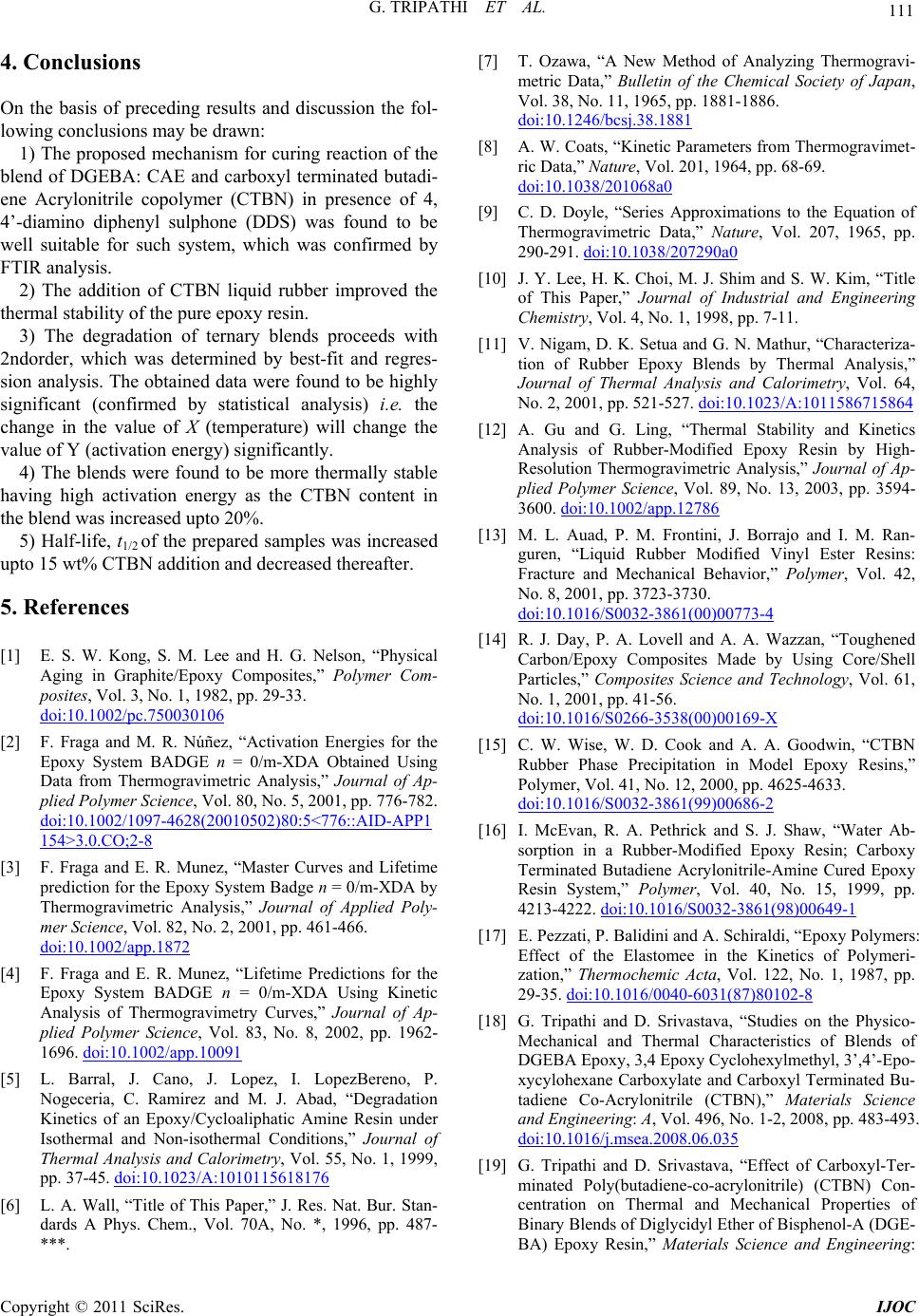
111
G. TRIPATHI ET AL.
4. Conclusions
On the basis of preceding results and discussion the fol-
lowing conclusions may be drawn:
1) The proposed mechanism for curing reaction of the
blend of DGEBA: CAE and carboxyl terminated butadi-
ene Acrylonitrile copolymer (CTBN) in presence of 4,
4’-diamino diphenyl sulphone (DDS) was found to be
well suitable for such system, which was confirmed by
FTIR analysis.
2) The addition of CTBN liquid rubber improved the
thermal stability of the pure epoxy resin.
3) The degradation of ternary blends proceeds with
2ndorder, which was determined by best-fit and regres-
sion analysis. The obtained data were found to be highly
significant (confirmed by statistical analysis) i.e. the
change in the value of X (temperature) will change the
value of Y (activation energy) significantly.
4) The blends were found to be more thermally stable
having high activation energy as the CTBN content in
the blend was increased upto 20%.
5) Half-life, t1/2 of the prepared samples was increased
upto 15 wt% CTBN addition and decreased thereafter.
5. References
[1] E. S. W. Kong, S. M. Lee and H. G. Nelson, “Physical
Aging in Graphite/Epoxy Composites,” Polymer Com-
posites, Vol. 3, No. 1, 1982, pp. 29-33.
doi:10.1002/pc.750030106
[2] F. Fraga and M. R. Núñez, “Activation Energies for the
Epoxy System BADGE n = 0/m-XDA Obtained Using
Data from Thermogravimetric Analysis,” Journal of Ap-
plied Polymer Science, Vol. 80, No. 5, 2001, pp. 776-782.
doi:10.1002/1097-4628(20010502)80:5<776::AID-APP1
154>3.0.CO;2-8
[3] F. Fraga and E. R. Munez, “Master Curves and Lifetime
prediction for the Epoxy System Badge n = 0/m-XDA by
Thermogravimetric Analysis,” Journal of Applied Poly-
mer Science, Vol. 82, No. 2, 2001, pp. 461-466.
doi:10.1002/app.1872
[4] F. Fraga and E. R. Munez, “Lifetime Predictions for the
Epoxy System BADGE n = 0/m-XDA Using Kinetic
Analysis of Thermogravimetry Curves,” Journal of Ap-
plied Polymer Science, Vol. 83, No. 8, 2002, pp. 1962-
1696. doi:10.1002/app.10091
[5] L. Barral, J. Cano, J. Lopez, I. LopezBereno, P.
Nogeceria, C. Ramirez and M. J. Abad, “Degradation
Kinetics of an Epoxy/Cycloaliphatic Amine Resin under
Isothermal and Non-isothermal Conditions,” Journal of
Thermal Analysis and Calorimetry, Vol. 55, No. 1, 1999,
pp. 37-45. doi:10.1023/A:1010115618176
[6] L. A. Wall, “Title of This Paper,” J. Res. Nat. Bur. Stan-
dards A Phys. Chem., Vol. 70A, No. *, 1996, pp. 487-
***.
[7] T. Ozawa, “A New Method of Analyzing Thermogravi-
metric Data,” Bulletin of the Chemical Society of Japan,
Vol. 38, No. 11, 1965, pp. 1881-1886.
doi:10.1246/bcsj.38.1881
[8] A. W. Coats, “Kinetic Parameters from Thermogravimet-
ric Data,” Nature, Vol. 201, 1964, pp. 68-69.
doi:10.1038/201068a0
[9] C. D. Doyle, “Series Approximations to the Equation of
Thermogravimetric Data,” Nature, Vol. 207, 1965, pp.
290-291. doi:10.1038/207290a0
[10] J. Y. Lee, H. K. Choi, M. J. Shim and S. W. Kim, “Title
of This Paper,” Journal of Industrial and Engineering
Chemistry, Vol. 4, No. 1, 1998, pp. 7-11.
[11] V. Nigam, D. K. Setua and G. N. Mathur, “Characteriza-
tion of Rubber Epoxy Blends by Thermal Analysis,”
Journal of Thermal Analysis and Calorimetry, Vol. 64,
No. 2, 2001, pp. 521-527. doi:10.1023/A:1011586715864
[12] A. Gu and G. Ling, “Thermal Stability and Kinetics
Analysis of Rubber-Modified Epoxy Resin by High-
Resolution Thermogravimetric Analysis,” Journal of Ap-
plied Polymer Science, Vol. 89, No. 13, 2003, pp. 3594-
3600. doi:10.1002/app.12786
[13] M. L. Auad, P. M. Frontini, J. Borrajo and I. M. Ran-
guren, “Liquid Rubber Modified Vinyl Ester Resins:
Fracture and Mechanical Behavior,” Polymer, Vol. 42,
No. 8, 2001, pp. 3723-3730.
doi:10.1016/S0032-3861(00)00773-4
[14] R. J. Day, P. A. Lovell and A. A. Wazzan, “Toughened
Carbon/Epoxy Composites Made by Using Core/Shell
Particles,” Composites Science and Technology, Vol. 61,
No. 1, 2001, pp. 41-56.
doi:10.1016/S0266-3538(00)00169-X
[15] C. W. Wise, W. D. Cook and A. A. Goodwin, “CTBN
Rubber Phase Precipitation in Model Epoxy Resins,”
Polymer, Vol. 41, No. 12, 2000, pp. 4625-4633.
doi:10.1016/S0032-3861(99)00686-2
[16] I. McEvan, R. A. Pethrick and S. J. Shaw, “Water Ab-
sorption in a Rubber-Modified Epoxy Resin; Carboxy
Terminated Butadiene Acrylonitrile-Amine Cured Epoxy
Resin System,” Polymer, Vol. 40, No. 15, 1999, pp.
4213-4222. doi:10.1016/S0032-3861(98)00649-1
[17] E. Pezzati, P. Balidini and A. Schiraldi, “Epoxy Polymers:
Effect of the Elastomee in the Kinetics of Polymeri-
zation,” Thermochemic Acta, Vol. 122, No. 1, 1987, pp.
29-35. doi:10.1016/0040-6031(87)80102-8
[18] G. Tripathi and D. Srivastava, “Studies on the Physico-
Mechanical and Thermal Characteristics of Blends of
DGEBA Epoxy, 3,4 Epoxy Cyclohexylmethyl, 3’,4’-Epo-
xycylohexane Carboxylate and Carboxyl Terminated Bu-
tadiene Co-Acrylonitrile (CTBN),” Materials Science
and Engineering: A, Vol. 496, No. 1-2, 2008, pp. 483-493.
doi:10.1016/j.msea.2008.06.035
[19] G. Tripathi and D. Srivastava, “Effect of Carboxyl-Ter-
minated Poly(butadiene-co-acrylonitrile) (CTBN) Con-
centration on Thermal and Mechanical Properties of
Binary Blends of Diglycidyl Ether of Bisphenol-A (DGE-
BA) Epoxy Resin,” Materials Science and Engineering:
Copyright © 2011 SciRes. IJOC